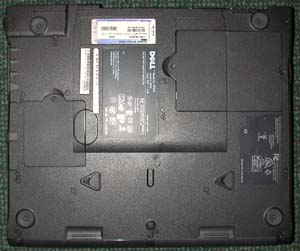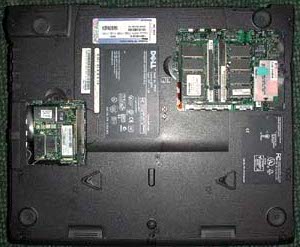Dell Inspiron 8200 Pentium 4-M 2.0GHz
by Matthew Witheiler on October 23, 2002 4:29 AM EST- Posted in
- Laptops
Construction - Build, Appearance, Size (Continued)
Although it looks bare, the front of the Inspiron 8200 is actually home to two bays. The right bay is solely a battery bay, able to accept one of the unit's battery modules. On the left is a bay that in our system was home to a second internal battery but can also be used for a number of other expansion options, including a floppy drive ($20) and a 250MB ZIP drive ($249). The modules slide in and out with ease and going from the second battery to the floppy drive is as simple as hitting the release on the bottom of the system and swapping out one for another. This makes for easy upgrade paths down the road, as one can start with no device in the left bay initially and later get the extra battery or ZIP drive if necessary. We have not seen many notebooks at AnandTech that offer such easy expandability. One reason that Dell is able to offer such a feature is because of the Inspiron's size. We'll get to that in a bit, but for now keep in mind that all these extras that the Inspiron 8200 offers do add up.
The left side of the Inspiron 8200 has a number of components on it. First up on the left side is the unit's left speaker. This location is fairly ideal when it comes not notebook speaker position as it should prove to be difficult to block the sound output during normal use. To the left of the speaker are the unit's connection jacks: an ethernet jack followed by a modem jack. The ethernet jack has two lights above it to indicate connection status just like a desktop network would. The next port is a TV-output port. Powered by the internal video chip, be it the GeForce2 Go, GeForce4 440 Go or Mobility Radeon 9000, the TV-out pot can display either S-video or composite output. The final item on the left side of the system is the system's optical drive. Our Inspiron 8200 came with a 24x10x24x8x CD-RW/DVD combo drive but an 8X DVD drive and a 24X CD-RW drive are also available for less money ($149 less for the DVD, $99 less for the CD-RW). The drive is fairly fixed but can be slid out by removing a screw and pulling the drive from its bay.
As a desktop replacement notebook the Inspiron 8200 offers a number of ports, many of which are located on the system's back side. The back right side is home to a set of two USB 1.1 ports mounted one on top of the other. The ports are slightly recessed and are thus flush with the back of the system. The next four ports are located in a rectangular cut out area as to prevent them from sticking out beyond the notebook's casing. The first of these ports is a serial port, an item becoming increasingly rare on notebook machines. To the left of the serial port is a parallel port, followed by Dell's proprietary docking station port and finally a VGA-out port. The final two ports on the rear of the Inspiron 8200 are a single PS/2 port and an AC power port.
The back of the Inspiron 8200 is also the place where cooling of the system occurs. The system consists of two cooling fans mounted on the back left of the unit. The fans actually exhaust air, not blow it in. This explains the 138 degree Fahrenheit (58.9 degrees Celsius) temperature we measured at this location. Air is drawn in from the vent on the left side and top of the machine and forced over the CPU heatsink surface thanks to the two small fans. The fans only run when necessary and are controlled independently so if only one fan is required to cool the system, only one fan will be active. The fans can be rather noisy when both are running at full speed but for the most part the fans are off or only partially running.
The first item to notice on the Inspiron 8200's right side is the large cooling vent; it is from here that the majority of cold air is taken to cool the CPU. To the left of the vent are two PCMCIA slots. The system can accept two type II or one type III PCMCIA card and on a system this size we would not expect anything less. The PCMCIA slots lie above the Inspiron 8200's audio connections and firewire port. On the audio side of things there are three 3.8mm audio jacks: one for speakers out, one for headphones out and one for microphone in. To the left of these ports is a single unpowered 4-pin IEEE-1394 firewire port. We are seeing more and more high-end notebooks come with IEEE-1394 ports standard but personally we would rather have USB 2.0 ports on our laptop than a single unpowered firewire port.
The unit's hard drive is also on the right side of the machine. The drive slides out fairly easily simply by removing a screw. The IR window is also found on the hard drive mounting bay. Finally, the front right side of the system is home to the right speaker.
There are two access panels on the bottom of the Inspiron 8200 along with two release levers. The two release levers serve as the battery and multibay release mechanisms and are very easy to operate. The access panel on the left side of the system is home to the MiniPCI slot. In the case of our system this slot was occupied with a 802.11b wireless network card which we will discuss in more depth in the Under the Hood section.
The back right access panel gives access to the units two 200-pin SODIMM slots as well as the internal modem.
As a full featured, very powerful desktop replacement notebook, it should be of little surprise that the Inspiron 8200 is very large. The system measures 1.75" x 13.03" x 10.8" and weighs 7.9 pounds with the CD-ROM and floppy drive installed. Remove the floppy drive and replace it with an extra battery like the one in our system and expect to tack on about another half pound to the system weight.
The Dell Inspiron 8200 is big, heavy, and cumbersome. As a desktop replacement machine that travels infrequently the machine's weight and size should be only a minor inconvenience. However, if you plan on carrying the Inspiron 8200 on the road with you, you better start lifting weights now; all this power and convenience comes at a price.
















1 Comments
View All Comments
Anonymous User - Monday, July 7, 2003 - link
I have had this pc for about six months now, and I am still in awe. My setup was not as good as the test model here, my processor is a 1.7 GHz and only 384Mb ram and the ATI 9000. I use this laptop for web surfing and internet gaming, mainly Diablo II(HC). This machine ROX.....